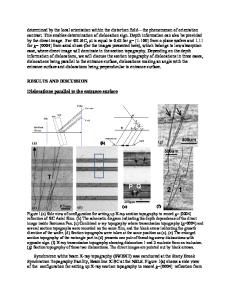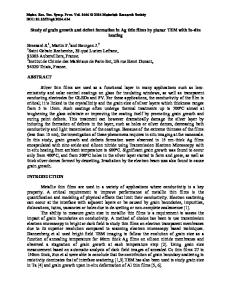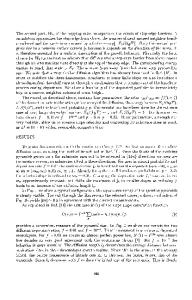Point and planar defect formation in SiC during PVT growth
- PDF / 454,156 Bytes
- 6 Pages / 612 x 792 pts (letter) Page_size
- 62 Downloads / 390 Views
Point and planar defect formation in SiC during PVT growth Yuri I. Khlebnikov1, Roman V. Drachev, Curtis A. Rhodes2, Dmitry I. Cherednichenko, Igor I. Khlebnikov and Tangali S. Sudarshan Electrical Engineering Department, University of South Carolina, Carolina, SC 29208, USA 1 Band Gap Technologies Inc. Columbia, SC 29208, USA. 2 Mechanical Engineering Department, University of South Carolina, Carolina, SC 29208, USA.
ABSTRACT The spontaneous nucleation of “negative” crystals from the solute of vacancies in SiC does not appear to be dominant due to the low super-saturation of vacancies. However, clustering of the vacancies is possible due to the energy gain in the system caused by coalescence of any two vacancies. The major reasons for point and planar defect formation in SiC are the liquid phase of free silicon and non-stoichiometry of the vapor. INTRODUCTION The different kinds of defects: micropipes, dislocations and several types of native point defects and their clusters still represent the primary problem for the production of high quality SiC crystals [1]. Although the solute of thermal vacancies tends to disappear during equilibrium cooling following the process of growth it was found by electrical and optical measurements that the concentration of native point defects in SiC is high, up to 1016-1017 cm-3. Planar inclusions (structural defects with lateral dimensions much larger than the defect thickness) are distinguished as separate sort of defects. Experimental observations of planar inclusions testify that they are mostly met in the form of localized hexagonal bulk voids (Figure 1). The presence of vacancies in high concentrations at SiC growth temperatures leads us to believe that planar defects are formed as a second phase of the supersaturated solute of vacancies during the cool-down phase of SiC bulk growth process. The discussion of probable mechanisms of point/planar defect formation and the participation of silicon liquid phase in this process represents the objective of this paper.
ANALYTICAL CONSIDERATIONS Equilibrium shape of planar defects A surface is in equilibrium if, at a constant temperature, its surface energy has a minimum value determined by [2]: E = ∫ γ (σ ) ⋅ dA ,
(1)
H5.1.1
10 µm
Figure 1. Planar defects in SiC (Optical microscopy image)
where γ(σ) is the surface tension energy of an elementary surface dA where σ is the normal unity vector. The surface tension of an isotropic material does not depend on surface orientation. Therefore the shape that minimizes the surface energy E will simultaneously minimize the surface area, E = γ ∫ dA = γ⋅A. But the equilibrium shape of a crystalline material follows the anisotropy of the specific surface energy of the crystal limiting faces. In this case, all faces with a low γ will have the maximal surface area Ai, E = ∑ γ i ⋅ Ai (where the index i = 1,2,3; γi is the i
specific surface energy and the factors Ai are the surface area of the corresponding crystallographic faces (Figure 2). Void shape with the minimum of surface energy can b
Data Loading...











